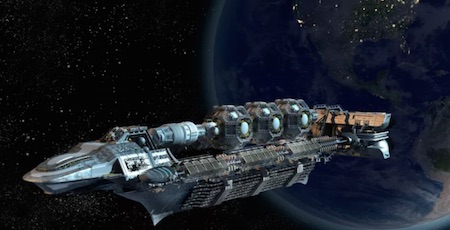Science Fiction
Dictionary
A B C D E F G H I J K L M N O P Q R S T U V W X Y Z
China Wants To Build Mega Space Ships

China is seriously considering building an enormous spaceship, possibly a kilometer in length.

(Concept of a giant spaceship orbiting Earth)
The project is part of a wider call for research proposals from the National Natural Science Foundation of China, a funding agency managed by the country's Ministry of Science and Technology. A research outline posted on the foundation's website described such enormous spaceships as "major strategic aerospace equipment for the future use of space resources, exploration of the mysteries of the universe, and long-term living in orbit."The foundation wants scientists to conduct research into new, lightweight design methods that could limit the amount of construction material that has to be lofted into orbit, and new techniques for safely assembling such massive structures in space. If funded, the feasibility study would run for five years and have a budget of 15 million yuan ($2.3 million).
Science fiction fans recall with awe the enormous fictional ships from Dune. Compare China's efforts with Frank Herbert's heighliners:
(heighliners from Dune)
Also, consider Dan Simmons' treeships from Hyperion:
The Consul remembered his first glimpse of the kilometer-long treeship as he closed for rendezvous, the treeship's details blurred by the redundant machine and erg-generated containment fields which surrounded it like a spherical mist, but its leafy bulk clearly ablaze with thousands of lights which shone softly through leaves and thin-walled environment pods, or along countless platforms, bridges command decks, stairways and bowers.
Scroll down for more stories in the same category. (Story submitted 8/13/2021)
Follow this kind of news @Technovelgy.| Email | RSS | Blog It | Stumble | del.icio.us | Digg | Reddit |
Would
you like to contribute a story tip?
It's easy:
Get the URL of the story, and the related sf author, and add
it here.
Comment/Join discussion ( 0 )
Related News Stories - (" Spacecraft ")
Europa Clipper Plate Carries A Special Message
'...a universal cryptogram — yet it is one which can be interpreted by any intelligent creature on any planet in the Solar System!' -
China Wants To Build Mega Space Ships
'Don't do anything to endanger our shipping privileges...' - Frank Herbert, 1965.
Dream Of Building Your Own Rocket?
Fiorello Bodoni, you inspire all of us.
Used Dragon Cargo Spacecraft Will Fly Again
'the overstrained meters made the smaller craft skittish as a young horse...' - Robert Heinlein
Technovelgy (that's tech-novel-gee!) is devoted to the creative science inventions and ideas of sf authors. Look for the Invention Category that interests you, the Glossary, the Invention Timeline, or see what's New.
Science Fiction
Timeline
1600-1899
1900-1939
1940's 1950's
1960's 1970's
1980's 1990's
2000's 2010's
Current News
The Zapata Air Scooter Would Be Great In A Science Fiction Story
'Betty's slapdash style.'
Thermostabilized Wet Meat Product (NASA Prototype)
There are no orbiting Michelin stars. Yet.
Could Crystal Batteries Generate Power For Centuries?
'Power could be compressed thus into an inch-square cube of what looked like blue-white ice'
India Ponders Always-On Smartphone Location Tracking
'It is necessary... for your own protection.'
Amazon Will Send You Heinlein's Knockdown Cabin
'It's so light that you can set it up in five minutes by yourself...'
Is It Time To Forbid Human Driving?
'Heavy penalties... were to be applied to any one found driving manually-controlled machines.'
Replace The Smartphone With A Connected Edge Node For AI Inference
'Buy a Little Dingbat... electropen, wrist watch, pocketphone, pocket radio, billfold ... all in one.'
Artificial Skin For Robots Is Coming Right Along
'... an elastic, tinted material that had all the feel and appearance of human flesh and epidermis.'
Robot Guard Dog On Duty
I might also be thinking of K-9 from Doctor Who.
Wearable Artificial Fabric Muscles
'It is remarkable that the long leverages of their machines are in most cases actuated by a sort of sham musculature...'
BrainBridge Concept Transplant Of Human Head Proposed
'Briquet’s head seemed to think that to find and attach a new body to her head was as easy as to fit and sew a new dress.'
Google's Nano Banana Pro Presents Handwritten Math Solutions
'...copy was turned out in a charming and entirely feminine handwriting.'
Edible Meat-Like Fungus Like Barbara Hambly's Slunch?
'It was almost unheard of for slunch to spread that fast...'
Sunday Robotics 'Memo' Bot Has Unique Training Glove
'He then started hand movements of definite pattern...'
Woman Marries Computer, Vonnegut's Dream Comes True
'Men are made of protoplasm... Lasts forever.'
Natural Gait With Prosthetic Connected To Nervous System
'The leg was to function, in a way, as a servo-mechanism operated by Larry’s brain...'
